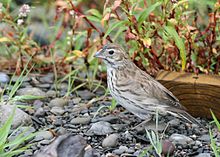Prairie bunting
| Prairie bunting | ||||||||||||
|---|---|---|---|---|---|---|---|---|---|---|---|---|

Prairie bunting ( Calamospiza melanocorys ), male |
||||||||||||
| Systematics | ||||||||||||
|
||||||||||||
| Scientific name of the genus | ||||||||||||
| Calamospiza | ||||||||||||
| Bonaparte , 1838 | ||||||||||||
| Scientific name of the species | ||||||||||||
| Calamospiza melanocorys | ||||||||||||
| Stejneger , 1885 |
The prairie bunting ( Calamospiza melanocorys ) is a songbird species found in North and Central America from the family of the New World chambers (Passerellidae). It is the state bird of the US state Colorado .
description
Appearance
Adult prairie bammers reach a length of 14 to 18 centimeters and a weight of about 30 to 50 grams. There is a noticeable sexual dimorphism between the sexes . During the mating and breeding season, the plumage of the males is black. Only the wings stand out clearly white. In winter, after moulting , they show a much less conspicuous drawing pattern, which has predominantly gray-brown elements with short black and white stripes. They then resemble the females, who show a gray-brown colored plumage with a lighter underside, which is only loosened up by a few short brown stripes throughout the year. The beak is short and strong and has a blue-gray color. The iris is black. Legs and feet are pink.
Vocalizations
The singing of the prairie bammers is a variable, rhythmic “chirping”.
distribution and habitat
The distribution area of the prairie Bunting extends from the southern prairie provinces of Canada Alberta and Saskatchewan south through the central US states as far as Mexico . She prefers to live in bushy prairie landscapes .
Way of life
The birds mostly stay on the ground, where they also look for food. This consists primarily of insects in summer and seeds in winter .
After mating, a bowl-shaped nest is built and hidden on the ground under low bushes. The clutch number consists of two to six eggs that are pale blue in color. After the young have been raised, the prairie bammers gather and fly in large swarms to the winter quarters, which are mainly in Mexico, Texas and California .
Danger
The prairie bunting is not uncommon in its areas of distribution and is therefore classified by the IUCN as a ![]() “ least concern ”. It is protected by the United States Fish and Wildlife Service under the Migratory Bird Treaty Act .
“ least concern ”. It is protected by the United States Fish and Wildlife Service under the Migratory Bird Treaty Act .
Individual evidence
- ^ Colorado State Bird
- ↑ Singing example
- ↑ Distribution area
- ^ IUCN Red List
- ^ Migratory Bird Treaty Act
Web links
- Prairie Ammer (Calamospiza melanocorys) in the Encyclopedia of Life . Retrieved August 11, 2017.
- allaboutbirds - All about Birds
